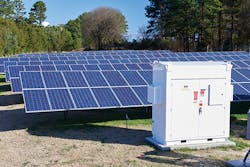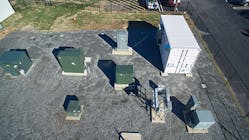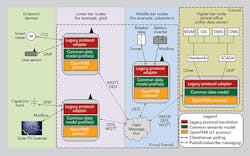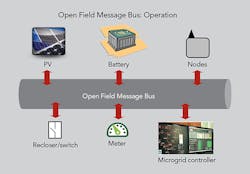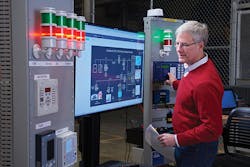An overall objective of an electric utility is to provide a more efficient, reliable and maintainable electric power system. To facilitate this, the development of enhanced information management systems is a prerequisite. Interoperability is the key to helping utilities operate the electric power system more simply and cost-effectively while also providing better service to customers. Historically, the back-office integration of information systems to achieve interoperability has been expensive and time-consuming.
The electric power system of the future will need to exchange information with different devices from many manufacturers locally in the field (outside of the central office) to achieve enhanced operational capabilities. In addition, traditional utility technologies and the associated data are often siloed, because they typically use proprietary, prepackaged hardware, telecommunications and software platforms that backhaul data to a centralized hub.
As such, development work is shifting away from the traditional centralized proprietary systems and evolving to support distributed intelligence, interoperability and the energy Internet of Things (IoT). Based in Charlotte, North Carolina, U.S., Duke Energy’s efforts to develop its smart grid have resulted in the enablement of these concepts through what the industry calls OpenFMB (Open Field Message Bus). It was showcased in a collaborative demonstration at the DistribuTECH 2016 meeting in Orlando, Florida, U.S.
First-Generation Deployment
Duke Energy’s initial smart grid efforts took hold in 2007 with a focus on establishing machine-to-machine connectivity to multiple grid devices with a 3G cellular backhaul. This led to the development and deployment of an Internet protocol (IP)-based node solution with multiple radios to facilitate use of the 3G backbone. As a result, the power line carrier (PLC) advanced metering infrastructure (AMI) and 900-MHz radio-frequency-based automated meter reading (AMR) systems being deployed were integrated into the node solution. In addition, the IP-based node solution also supported Wi-Fi-based medium-voltage sensors and serial devices used to improve distribution automation.
This first phase of Duke Energy’s smart grid technology resulted in the deployment of approximately 150,000 nodes equipped with 3G cellular, PLC, Wi-Fi and 900-MHz radios attached to approximately 500,000 PLC meters and 10,000 Wi-Fi-based medium-voltage line sensors.
Circa 2010, the first-generation equipment was expanded with the addition of integrated streetlight control. LTE or 4G cellular technology was retrofitted to the node to operate capacitor banks. Weather sensors were also integrated with the upgraded LTE-based nodes. Partial discharge and secondary load-monitoring capability were added to the node-based system, along with Wi-Fi-based voltage regulators. In addition, 3G cellular nodes supporting multiple cellular carriers were introduced, thereby improving reliability and resulting in cost improvements by avoiding carrier lock-in.
The initial deployments and first-generation pilots evolved through expansion into the start of an integrated grid ecosystem by 2012. It was comprised of three substations in the Charlotte area: Sherrill’s Ford, Rankin and McAlpine. Substation components included solar photovoltaics, energy storage and connection to distribution management system software, six phasor measurement units and seven weather stations.
Within one of the substation test sites, McAlpine, six distribution circuits were further enhanced with community energy storage, intelligent switches and 3,000 IP-based nodes connected to more than 200 medium-voltage line sensors and 14,000 AMI meters. Lastly, approximately 60 homes served by the McAlpine circuits were equipped with solar photovoltaics, a home energy manager system, plug-in electric vehicle charging stations, smart appliances, demand-response systems and in-home load monitoring.
First-Gen Lessons Learned
The first-generation deployments and pilots provided substantial insights into what improvements the present-day smart grid would require. Most first-gen technologies supported a single purpose or function. The initial smart grid systems were predominantly proprietary and siloed. The data from these systems was latent and error-prone. Operational technologies, information technologies and telecommunications assets were not well integrated and only limited field interoperability existed. In essence, the present-day smart grid makes largely centralized decisions that can be slow, stale and unsecured.
There were several key takeaways for ensuring a more efficient, cost-effective and secure grid. First, leverage existing grid infrastructure and underused assets to minimize rework and better manage costs that were hidden as a result of inefficiencies associated with siloed, single-function solutions. Next, reduce effort in device configuration, management and commissioning where possible to improve efficiency and reduce complexity. Also, back-office integration can be expensive and time-consuming, and should be minimized through proper software and protocol selection. Likewise, the complexity of big data can be caused by many small-data problems.
Consequently, it was noted that while present-day systems struggle to deliver field interoperability, it is becoming more important because new grid-edge applications such as distributed energy resources, microgrids and advanced demand response require disparate field devices to work together remotely with little latency or delay. Furthermore, the use and adoption of open standards is a key to enabling interoperability, but does not necessarily mean all systems that deploy them are interoperable.
Lastly, the goal for future grid systems should entail technologies that enable fast, distributed decisions that can be local, actionable and secure. These should support multipurpose functions on modular and scalable hardware and software. Future systems also should support the convergence of operational technologies, information technologies and telecommunications solutions that enables the end-to-end situational awareness needed for true field interoperability.
Guiding Principles
The OpenFMB framework was designed based on lessons learned from the first-generation systems. Because there is not a one-size-fits-all technology capable of integrating distributed energy resources with the existing transmission and distribution assets, an agile and evolving architecture is an essential trait. Flexibility in the selection of a common data model and publish/subscribe protocol is desired. Also, the desire was not to reinvent the wheel nor duplicate any existing standards efforts. The focus was on quickly getting business value by solving real problems. As such, flexibility, scalability and backward compatibility are critical features as well as ensuring security and configurability are built in from the start.
According to the Smart Grid Interoperability Panel (SGIP), the OpenFMB is currently comprised of a reference architecture and a framework for distributed intelligent nodes interacting with each other. It represents economical industrial IoT technologies applied to the smart grid, and distributed resources communicate through common semantics, such as the common information model (CIM). The OpenFMB allows grid-edge nodes to federate data locally for control and reporting, and also supports field-based applications that enable a scalable peer-to-peer publish/subscribe architecture. The OpenFMB supports distributed logic as well as centralized logic for harmonized system and device data.
What Is Different?
After its inception by Duke Energy, the effort has been led by utilities (largest investor-owned utilities, municipals and cooperatives) based on their priorities and interoperability demonstration experience. OpenFMB is intended to reduce latency and create distributed intelligence opportunities to manage local grids in the most efficient way, based on local resources and conditions. It also supports the retrofit of legacy equipment to provide new capabilities, features and extended equipment life, while facilitating data integration across previously siloed domains within the utility. The notion of employing a data-centric bus to secure information, data topic by data topic, is a key differentiator over the traditional method of applying security at the transport layer.
Substantial effort has been undertaken to gain industry adoption of OpenFMB. In early 2015, Duke Energy published its Distributed Intelligence Platform Reference Architecture as a starting point for standards strategy task forces at the SGIP and for a demonstration, and also for specification development with the North American Energy Standards Board (NAESB), targeting a 2016 specification release.
In parallel, supporting utility partnerships and research alliances have been undertaken since 2014. Southern California Edison, Detroit Edison, CPS Energy, Ameren and NRECA have all established partnerships. Duke Energy also has participated in U.S. Department of Energy lab programs along with a related Electric Power Research Institute program. In addition, the utility has been actively recruiting vendor support for three years.
Duke Energy implemented a Coalition of the Willing concept that involved six vendors in an interoperability demonstration at DistribuTECH 2014 and completed another large interoperability demonstration at DistribuTECH 2016, involving approximately 25 vendors. One demonstration vendor, OMNETRIC Group, has committed to commercialization. OMNETRIC Group has been involved in the technology development since the formation of the joint venture between Accenture and Siemens in 2014.
Coalition of the Willing, Phase II
Duke Energy has been working for nearly 18 months with more than 25 vendors, of which at least two vendors were selected to demonstrate each function. Leveraging both wired and wireless communications, the Coalition demonstrated portions of the following three dynamic use cases at DistribuTECH 2016:
• Microgrid optimization
• Seamless island transition
• Successful reconnection.
Furthermore, by enforcing a common data model, based on the International Electrotechnical Commission CIM, and multiple pub/sub protocols — such as MQTT, DDS and AMQP — in its design, the coalition can be considered the first reference implementation of the OpenFMB framework.
Expected Benefits
OpenFMB should provide new open, observable and auditable interfaces for situational awareness. OpenFMB provides interoperability with existing assets, eliminating the need to rip-and-replace them. It can provide for fast response when centralized sites are too far away to respond. It also can provide resiliency when portions of the grid are segmented. OpenFMB also can support local intelligence with coordinated self-optimization. It has the potential to provide a unified backhaul for reduced operations and maintenance, simplified management and enhanced security. Lastly, OpenFMB fosters innovative products and services.
Importance for Duke
OpenFMB can provide accurate control and alleviate intermittency of distributed energy resources. It also should provide the ability to scale independently, as needed, without requiring a systemwide rollout. In addition, it has the potential to lower costs by reducing related integration time and effort. OpenFMB also should provide enhanced security as a distributed grid is more resilient and can be made more secure. It also enables Duke Energy to be at the forefront of developing new applications, policies and procedures.
Stuart Laval is a manager of technology development in Duke Energy’s emerging technology office and also serves as the OpenFMB co-chair on both the Smart Grid Interoperability Panel and North American Energy Standards Board standards task forces. Prior to Duke Energy, he spent more than 10 years developing products for manufacturers of utility equipment, cellular radios and power electronics. Laval holds a Ph.D. in industrial engineering.
Wade P. Malcolm is the Americas CEO of OMNETRIC Group, a Siemens and Accenture company, focused on leveraging the convergence of information and operations technology for the benefit of utilities. As a former transmission and distribution engineer, he enjoys developing and applying advanced technologies to the grid to improve the products and services utilities offer. Malcolm is a professional engineer.
Coalition of the Willing Vendors
- ABB
- AT&T
- CalAmp
- Cisco
- Ericsson
- GE
- Green Energy Corp.
- Honeywell elster
- ITOCHU Sierra Wireless
- Itron
- Leidos Engineering
- Moxa
- National Instruments
- Nokia
- OMNETRIC Group
- Parker Hannifin
- PrismTech
- RTI
- S&C
- Schneider Electric
- Schweitzer Engineering Laboratories
- Siemens
- Silver Spring Networks
- Verizon

